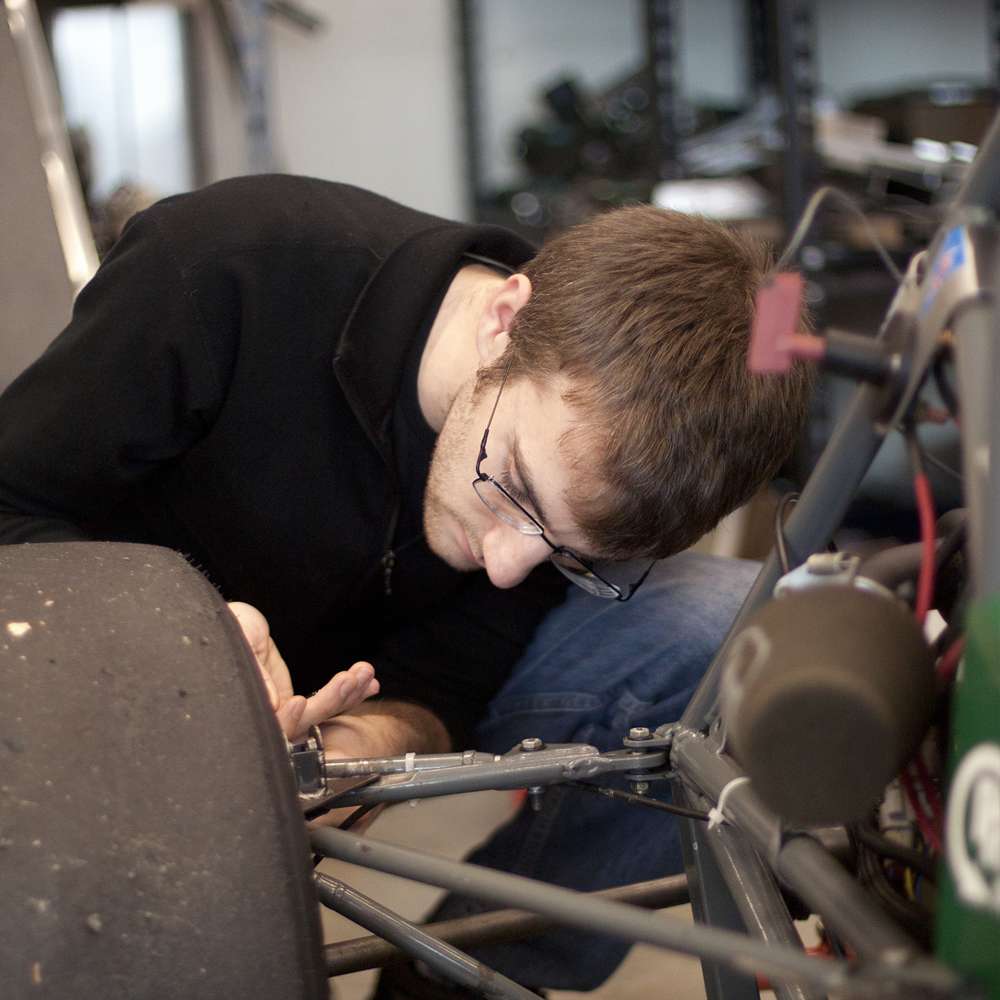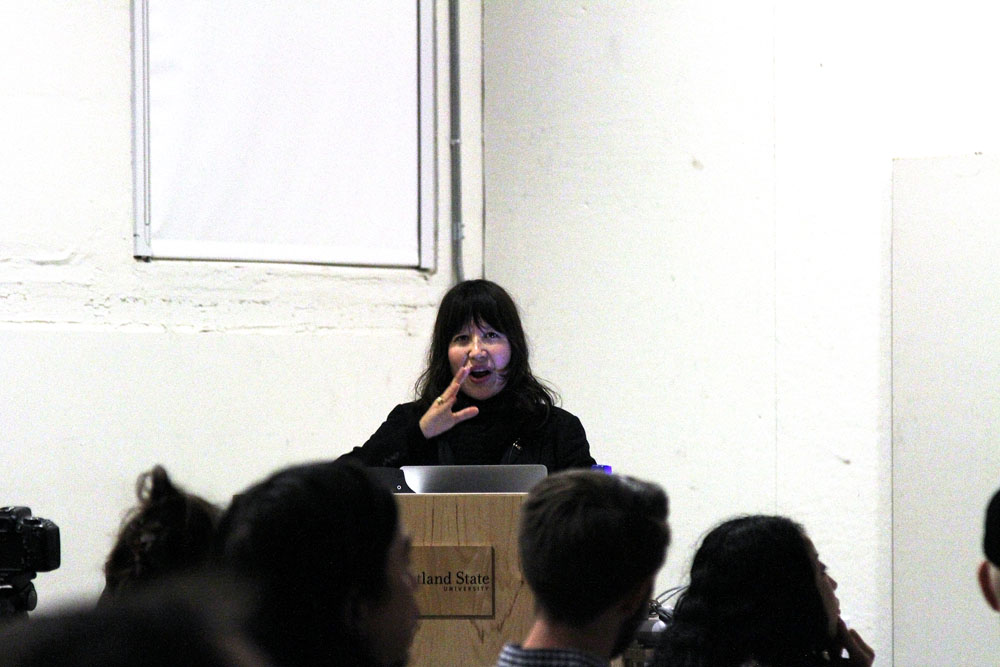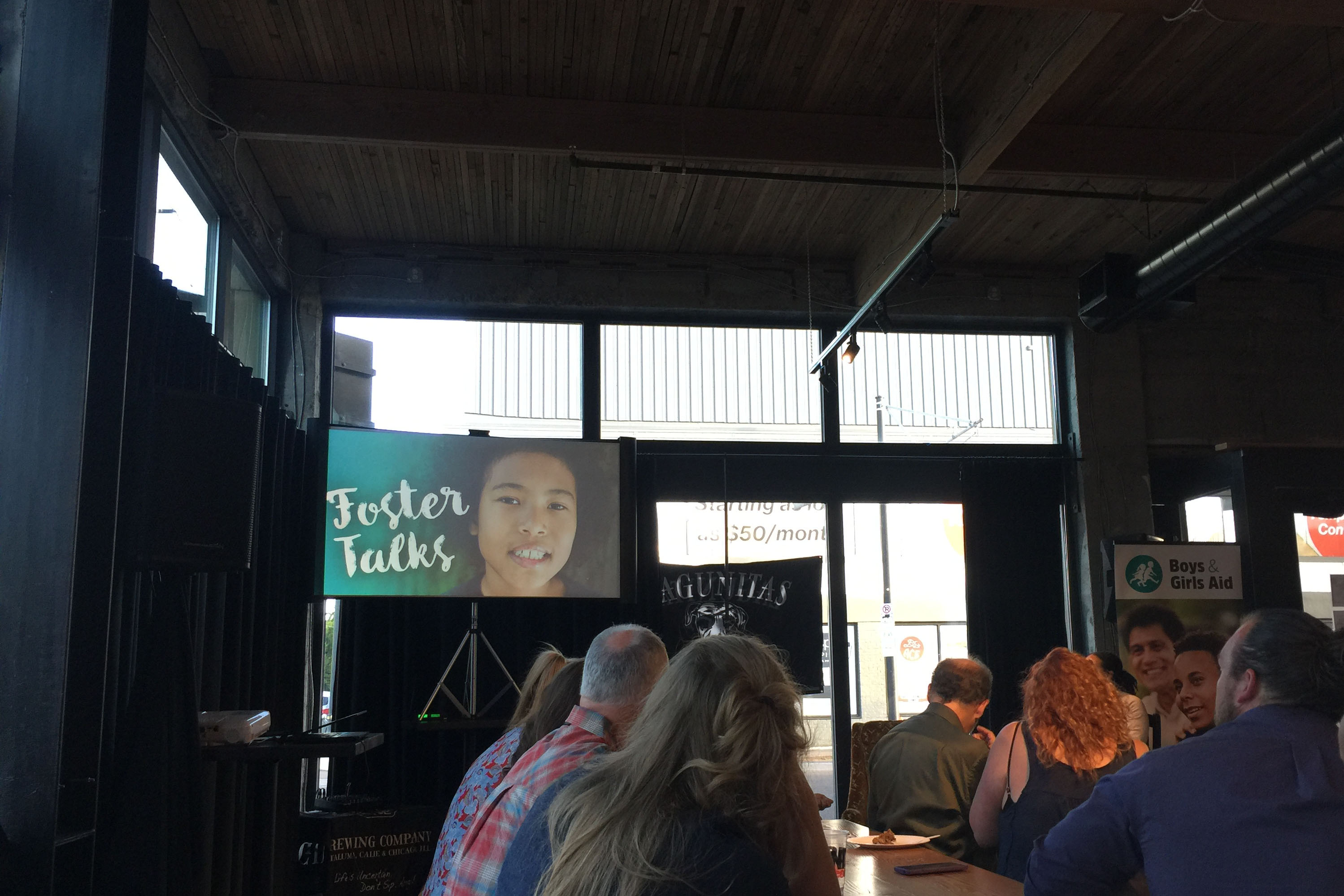Building a race car isn’t easy, and building a fast one is harder. Pulling it off takes years of experimentation and dedication, financial backing, know-how and guts. Add to that the need for fast, competent drivers and build regulations that can change from one year to the next and the order grows taller—and that’s just for one car. To ante up and throw a second car into the fray while powering it with a different, relatively new technology could be seen as foolishness—or confidence. Either way, on the fourth floor of Portland State’s engineering building, the students of Viking Motorsports are doing just that.
The objective is simple: Teams prepare their vehicles to the satisfaction of a fictitious manufacturing firm that’s looking to produce a small race car for non-professional motorsport enthusiasts.
That’s Formula SAE, one of the largest student design competitions in the country. The groups’ efforts culminate in annual competitions, where university teams from around the world assemble to snap up as close to 1000 points as possible. Teams must design and construct a car that’s not only quick and safe, but also meets numerous other criteria, including confidence-inspiring business presentations and spot-on technical inspections.
“It’s a big project,” said Troy Brown, technical director and vice president of Viking Motorsports, which is also known as VMS. “It’s like running a small business, and we have to do everything on our own.”
While the team has multifaceted needs and welcomes students with all kinds of skills, Brown said that new members don’t always stick around.
“The attrition rate’s pretty high right off the bat because people don’t know what they’re getting into.”
Traditionally sanctioning petroleum-powered cars, FSAE held its first electric competition in 2013. While the electric car will be a first for VMS, Brown said the group, which first came together in 2001, plans to draw from its own past experience with gas-powered cars.
Brown, a 22-year-old mechanical engineering student, is in his second year at VMS. He said support and advising from professionals in the industry are vital to the group’s efforts, and when it comes to engagement from the industry, there’s a willingness to embrace newcomers to electric racing that ends up being harder to earn for those using gas.
“Working with electric [motorsport] companies has been a lot more fruitful,” he said, adding that electric racing has only become practical within the last 10 years. “Gas racing has been around for ages, so you’re just the new kid on the block.”
Brown said that donated time and resources mesh with the team’s effort to produce as much of the car on their own as possible. “We’re trying to do as much in-house as we can,” he said.
Going Electric
“Oh man, it’s been a lot of work,” said Quinn Sullivan, a first-year master’s student at PSU studying electrical engineering. He’s also the Formula Electric manager at VMS and is hardly new to the idea of an electric race car.
“I’ve actually been personally interested in electric vehicles for several years,” he said. “I built my own electric car as a personal vehicle out of a two-door Saturn.”
Sullivan doesn’t think either of the cars will be the “easier” one to work with. “I think there’s give and take,” he said. While an electric setup is more mechanically simple, it also comes with more complicated electronics and software to manage it all.
“It’s too soon to tell if any one of those things will take more or less time,” Sullivan said. “It could go either way.”
At this point, the group is designing an oil-based cooling system for the new car’s electric motor. Without it, Brown said, the motor could overheat to the point of becoming impractically sluggish.
Brown said the stresses these motors are put through ultimately determines how warm they’ll get.
“We’ll be seeing a lot higher temperatures than you do in a production car,” he explained. “A production car goes very slow speed for a long distance, and we’ll be jumping up to high speeds… [and] pulling a lot of power through the motor pretty much constantly.
“So you might see much higher temperatures in [competition cars] than you would in other applications.”
Both Brown and Sullivan said that the infancy of the electric class at Formula SAE played a large part in their decision to go for an electric car last summer. Sullivan said that last year, of the “20 teams that were registered, only five arrived with operational cars, and only one of them passed technical inspection.” The competition, then, was wide open.
Add to that the fact that VMS already had trailer space for a second car, and the decision to go electric nearly made itself.
Onward and upward
Scott Brenaman was the technical director at VMS for two years before graduating from PSU in 2011. These days, he’s a mechanical engineer at Pratt and Miller, an engineering firm that does general defense and motorsport work in New Hudson, Mich. He works in the aerodynamics department on projects for Chevrolet’s campaign in IndyCar, a professional auto-racing series held mostly in the U.S.
Brenaman said that the atmosphere at VMS changed quite a bit over the time he was there. When he first came on as a regular team member in 2009, most of his work focused on the car’s suspension—but only for the first year.
The next year, he said, “I wanted to grow the project into something bigger.”
That effort revolved around fostering a more cohesive, professional atmosphere within the team, as well as sharpening their public appearance. Before 2010, VMS had only been able to pass their technical inspections.
That year, however, was a breakout for the group, seeing them finish 37th of 56 teams. In 2011, they were 24th of 61.
2012 had VMS finishing 16th of 77 competing squads—far and away the teams most successful year.
“By the end,” Brenaman said, “it’s really starting to be [more than] just a handful of engineering students who manage to dress up halfway nice.”
“There was just a really high degree of pride and professionalism that hadn’t been there the first year I was there.”
However, Brown said that as former VMS members graduated, their knowledge and organizational effort often graduated with them.
At the gas-powered competition in 2013, late paperwork meant that VMS was docked 100 points in the final classification, knocking them down 17 places from 29th to 46th. Without that penalty, Brown said, VMS would have placed within the top quarter of teams worldwide.
“It was a good car,” he said in an email, “we just didn’t have the organizational structure or the leadership in place to pull it off at the time.
“I and a couple others got to experience that fault and we are making sure it’s not a problem this year.”
Brown said that, going forward, one of the team’s priorities is to build up a library of technical documentation that can be handed down to the next batch of VMS members. “You start building up a knowledge base and moving up from there,” he said.
According to Brenaman, many of the engineering students on VMS use the experience to prepare for their livelihoods. “For many of us, a sense of pride comes from being a good engineer.
“Overall, I think it’s a really awesome opportunity for any student that especially wants to get into the engineering or technology field after they graduate,” he said, adding that Formula SAE’s focus on race cars is a large part of what compels students to participate.
“[The organizers] really just use [Formula] SAE as a carrot to dangle in front of your face,” he said.
A hypothetical “Formula Wheelbarrow,” he added, would probably draw a smaller crowd.





